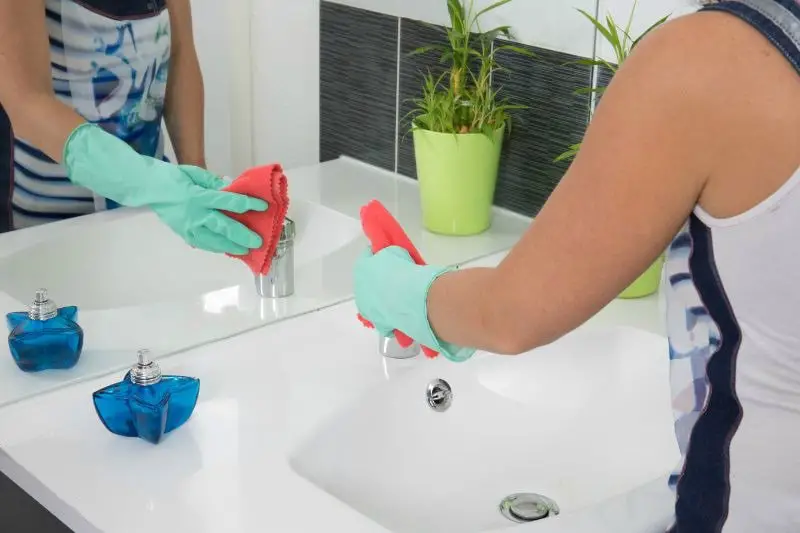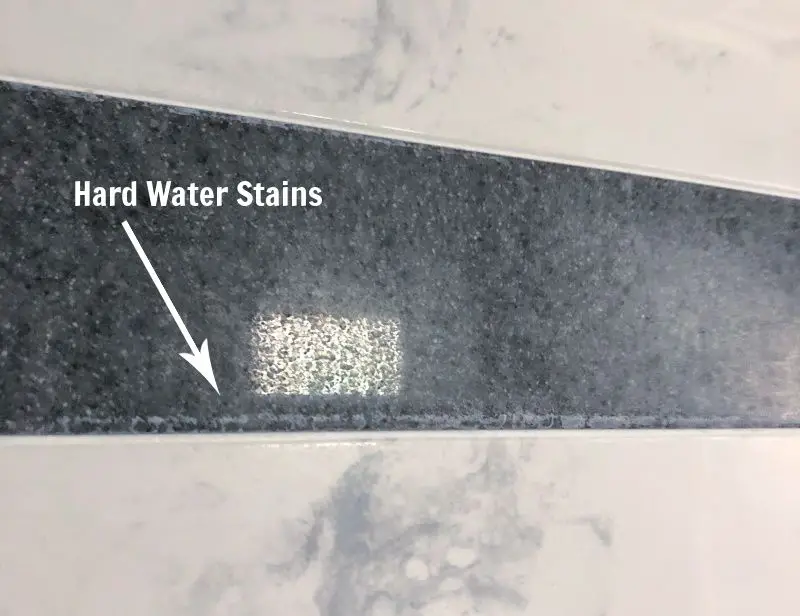How To Clean Cultured Marble Countertops and Showers

Learning how to clean cultured marble properly is essential to avoid damage and maintain all surfaces in like-new condition. Cleaning cultured marble showers, sinks, countertops, and vanity tops is easy enough, but you can’t just go at it willy-nilly with any type of cleaner. Specific care is needed.
ON THIS PAGE
First, it’s vital to know that cultured marble is not real marble. It’s a common point of confusion. Cultured marble is a man-made solid-surface material made with marble dust and resins. It is similar to Corian countertops.
Cleaning and maintenance requirements, repair options, and types of products used are different from regular marble and other materials.
Follow the recommendations provided in this detailed guide, and you’ll know how to clean cultured marble like a pro.
Related Content on How To Clean Cultured Marble:
- Repairing Cultured Marble: Scratches, Cracks, Polishing, and Refinishing
- Cultured Marble vs. Marble: What's The Difference?
- Cultured Marble vs. Corian, Quartz, and Granite
Do’s & Don’ts for Cleaning Cultured Marble:
To keep your cultured marble in top condition, you must use the proper cleaners, avoid damaging products, and develop good maintenance habits.
Cultured marble is durable, but quality does vary, and often it can be damaged by many common and brand-name household cleaners.
You may read that certain products or cleaners are safe to use, but in fact, it’s a gamble. You risk scratching or discoloring the finish. Even manufacturers give contradicting recommendations.
Popular cleaners used only once or twice may not damage. But when used regularly, they will ruin the cultured marble. Better safe than sorry.
For Regular Cleaning
Spray on a pH-neutral cultured marble cleaner. Using a soft cloth or non-abrasive sponge, wipe down the surface and buff dry to eliminate streaks. Do not use any harsh or abrasive cleaners or scrubbers.
Apply this Gel-Coat product periodically to maintain the glossy shine. This Topical Marble Polish works great as well.
You’ll clean cultured marble sinks the same way as the countertop. The same rules apply.
Follow all guidelines presented here for cultured marble bathrooms. But see the specific section below on cleaning a cultured marble shower. Showers and tubs have some special needs.
Soap or a mild detergent is commonly recommended but is counterproductive (see why below).
- Use a pH neutral hard surface cleaner like Puracy for daily cleaning. A quality Marble Cleaner (made for real marble) is also an excellent and safe cleaner for cultured marble.
- Avoid using soap as a general cleaner. When used regularly, even a mild soap or detergent will create a soap scum film on the surface. This film looks dull and dingy and makes the surface even harder to clean over time. Also, it is hard to remove without potentially damaging the finish. It’s precisely the same problem as seen in showers.
- Apply Gel-Gloss Polish for cultured marble regularly to maintain the like-new shine, condition the gel coat, buff out surface scratches, and make the surface easier to clean.
- Do not use abrasive cleaners, abrasive pads, steel wool, scrapers, or sandpaper (except when repairing as detailed below).
- Note: mild abrasive pads or cleaners like Soft Scrub may be gently used on a “matte” finish but only when needed to remove light stains.
- Avoid contact with strong, caustic, acidic cleaners, citrus cleaners, harsh chemicals like bleach, paint removers, drain cleaners, oven cleaners, and acetone (including fingernail polish remover), ammonia, and vinegar.
- Do not use hair dyes or any similar dyes around cultured marble. Dyes tend to stain.
- Avoid water temperatures of 140 degrees Fahrenheit or more. Repeated exposure to extremely hot water can cause cracks. This commonly happens around the sink drain. Normal water temperature from your water heater should be around 125 - 140 degrees Fahrenheit.
- Hot objects will scorch, burn, or even melt the surface. Do not place hot pans, cooking appliances, or hair-styling tools directly on the surface or you’ll likely need to refinish the surface. Quite a project!
For instance, removing curling iron burns from cultured marble is a common issue on bathroom vanity tops.
Use trivets for hot pots or a silicone hot mat to set larger hot things on to protect the surface.
Important Tip: Some cultured marble care guidelines you read online are contradictory, even from a few cultured marble manufacturers.
You may read recommendations to use white vinegar, ammonia, or bleach to clean cultured marble showers or remove hard water stains. But many cultured marble manufacturers specifically state not to use acids like vinegar and other strong cleaners like chlorine bleach as these can damage the gel coating.
Or to avoid acetone, but then also say to use acetone to remove nail polish, ink, or other gunk stuck to the surface. Go figure!
What Should You Not Use On Cultured Marble?
You’re probably wondering if certain cleaners or your favorite product should be used to clean cultured marble. Many common cleaners are not safe.
Stick with a quality pH neutral cleaner and soft cloth or sponge.
Do NOT use the following cleaners:
- Clorox Wipes will damage cultured marble. Clorox Wipes contain bleach, which may dull the protective gel coat of cultured marble.
- Bar Keeper’s Friend should not be used as a cultured marble cleaner. It is both acidic and abrasive and can scratch and dull the finish.
- Soft Scrub is not safe to use as it is abrasive and contains bleach. Like Bar Keeper’s Friend and Clorox Wipes, it can ruin the shine and finish.
- Windex and other window or glass cleaners should not be used on cultured marble. These are not as harsh as other cleaners, but repeated use can still cause damage. When cleaning mirrors, spray Windex on the cloth first to avoid overspray onto the countertop.
- CLR, Lime-Away or other hard water stain or calcium deposit cleaners. Use a safe non-acidic Hard Water Remover instead.
- Oven cleaners and drain cleaners will cause severe damage and should not be used on or around this countertop material.
- Ammonia, which has a high pH (like bleach) and can ruin the finish and gloss.
- Vinegar should not be used for cleaning cultured marble. White vinegar (and all other types) is a strong acid. Acidic chemicals will dull or etch the surface when used as a regular cleaner.
- Hydrogen peroxide. Do not use it as It is acidic and will etch or damage the gloss finish.
- Acetone is a solvent that will damage cultured marble surfaces. It will dissolve the gel coat finish. Also, do not use fingernail polish remover as it contains acetone.
- Comet or other abrasive powdered cleaners. These will scratch and dull the finish.
- Abrasive scrub pads or steel wool will cause scratches and dullness. Do not use.
Some of these cleaners are effective when making a repair or removing a stain but may scratch or dull the resin coating in the process. So use with caution and only when really needed as part of a repair or stain-removal process.
If you choose to try these harsh chemicals, then test the cleaner first on a small hidden area to ensure it will not damage. Not all cultured marble is exactly the same, so results may vary.
Cleaning Cultured Marble: High Gloss vs. Matte Finish
The vast majority of cultured marble materials come with a high-gloss finish. It’s the protective outer layer of clear coating that creates this shiny surface. But a matte finish is also available now to suit different tastes in design.
Cleaning requirements are basically the same, with a couple of nuances between the two types.
High Gloss Finish
A high-gloss cultured marble surface will show dust more readily and may need daily cleaning to keep it looking its best. This is especially true for surfaces with a minimal pattern or a solid color.
Again, avoid using soap as a cleaner. It won’t harm the cultured marble directly, but a dull film can build up on the surface when used regularly. This oily film is challenging to clean and can lead to discoloration.
Instead, use a marble cleaner or non-abrasive, all-purpose cleaner like the highly-regarded Puracy for proper cleaning. It’s non-toxic, biodegradable, super-effective, and dries streak-free.
Apply the cleaning product with a non-abrasive pad, soft sponge, or a microfiber cloth.
An abrasive sponge or cleaner will scratch the resin coating, causing dull spots or a hazy finish. Never use an abrasive cleaner or pad for regular cleaning. The only exception is when necessary for stain removal and repairs (see more below).
Polish for Cultured Marble
How do you make cultured marble shine again?
Apply Gel-Gloss Polish regularly to keep cultured marble shiny or restore the glossy shine.
This product is specific for polishing cultured marble. It functions like car wax or fiberglass polish. It will protect the top layer gel coat and maintain the luster of the high-gloss finish.
Gel-Gloss will buff out light surface scratches and make regular cleaning a snap.
A Topical Marble Polish is also a good choice for regular maintenance and enhancing the shine.
If your cultured marble vanity, shower, or tub is really dull, damaged, or yellowed, then you will need to repair or refinish it first. But Gel-Gloss is used as part of this polishing and refinishing process as well.
Matte Finish
This type of cultured marble finish won’t show dust and dirt as readily as a high-gloss finish, but smudges and fingerprints can be more evident on darker colors.
Use the same non-abrasive cleaning products recommended above for general cleaning.
Although a matte finish can stand up to abrasive cleaners better than a polished finish, consistent use can wear on the finish leaving it looking more dull or hazy.
How To Clean a Cultured Marble Shower
Soap film buildup and hard water stains are the biggest cleaning problems for cultured marble bathrooms, tubs, and showers. The Soap Film & Hard Water Cleaner is specially-formulated for safe and effective cleaning for showers and tubs.

Actually, this is true for showers made with natural marble, natural stone, acrylic, fiberglass, etc. All showers have this problem.
Soap scum leaves a dull, hazy film on the shower walls and floor. Mineral deposits in the water create crusty white or yellowish deposits around the drain in the shower base or on shelves and seats in the shower.
Removing excess water with a squeegee after showering can help minimize buildup and make cleaning easier.
These same problems can occur on a cultured marble bathtub or around sink faucets and drain as well.
And both types of films can lead to the growth of mold and mildew.
Steps to Clean a Cultured Marble Shower:
- Apply a non-acidic Hard Water & Soap Scum Remover.
- Let the product sit and soak for 5-10 minutes.
- Scrub with a non-abrasive pad or scrub brush.
- Rinse and Repeat until clean.
- Use the same Hard Water & Soap Film cleaner for regular cleaning to eliminate problems with soap film buildup, water spots, hard water stains, and mold.
Beware Contradictory Recommendations
Many sites suggest using diluted vinegar (acidic) and a cloth to remove hard water stains or even covering the area with a cloth or paper towels soaked in vinegar, but it's a big risk.
Vinegar is a commonly accepted and effective household cleaner for many purposes. It can remove hard water deposits, but it may also damage the finish of cultured marble, real marble, and other surfaces.
So be careful what cleaning product you use. Always test on a small hidden area first.
As noted above, many cultured marble manufacturers state to avoid acidic cleaners and other strong chemicals.
What is a bit ironic and comical is that some sites will recommend both using vinegar (which is acidic) in one sentence while also stating to avoid anything acidic—same contradiction with acetone.
The safe bet is to use the non-acidic Soap Film & Hard Water Remover to clean a cultured marble bathroom. It works great on grout as well and as a marble cleaner. However, cultured marble showers don't usually have grout lines like real marble.
Again, use it as your regular shower cleaner to remove water spots, hard water stains, soap film buildup, and mold growth or mildew. This product makes it easy to maintain squeaky clean shower walls and floor.
Does Cultured Marble Stain?
Cultured marble is durable and resistant to most stains. But it can stain from hair dyes, ink, shoe polish, nail polish, some foods and drinks, colored waxes, and oils.
Stains don't always or easily occur from such substances, but it is possible and does happen.
Removing Cultured Marble Stains
To remove stains in cultured marble, you may have to use products that you should not use for regular cleaning, as noted above. It’s a bit of a catch-22.
So it’s a judgment call. Remove the cultured marble stain but risk other damage to the gel coat. However, refinishing the protective gel-coat is possible. So in many cases, this is the only way to get out stubborn stains. The key is to test first and don’t be too aggressive.
Ink Stain Removal
To remove cultured marble stains from ink, nail polish, dyes, or anything stuck on the surface, try isopropyl alcohol on a cotton ball and gently rub.
Or use a non-acetone fingernail polish remover (note that most fingernail polish removers contain acetone).
Food, Oils, and Other Stains
For general stain removal, gently scrub using an extremely fine grade Scotch Pad, an abrasive sponge, or Soft Scrub.
As noted above... abrasives may damage the protective glossy gel-coat. So you may have to repair the finish with a polishing compound after removing cultured marble stains.
Procedures for stain removal are the same for cultured marble sinks, showers, tubs, vanities, and cultured marble countertops.
How To Clean Cultured Marble That Has Yellowed
Cultured marble can be maintained in excellent condition for a long time if you follow the above guidelines for proper cleaning and care.
Over time cultured marble can yellow for a couple of reasons.
- Lack of natural light or fresh air in the bathroom can cause the surface to yellow after many years.
- Repeated use of abrasives or harsh cleaners is another reason. Abrasive and harsh cleaners rough up the gel-coat, which then accumulates dirt and oils, making it harder to clean. This leads to a vicious cycle.
Generally, you see yellowed cultured marble when removing an old faucet. Underneath will be yellow. But also if you keep a soap dish or any kind of decor item in the same place, it can yellow underneath.
Steps to clean yellowed cultured marble:
- Mix a very dilute bleach solution (1 capful of bleach added to a 32 oz. / quart spray bottle full of water).
- Allow the dilute bleach solution to dwell on the surface for 5 minutes.
- Scrub gently with a non-abrasive pad.
- Rinse thoroughly with clean water.
- If the above procedure doesn't work, then you may have to sand down and refinish the cultured marble surface.
Do not let the bleach solution sit on the surface for too long. Apply it and scrub a bit, then rinse it very well. Repeat until yellowing is removed.
WARNING: Bleach or products containing bleach should never be used as a regular cultured marble cleaner. Use only when attempting to remove yellowing.
Can Cultured Marble Be Refinished?
Yes. As long as the protective gel-coat remains, it is possible to refinish cultured marble. You can refinish cultured marble yourself, but it may be best to hire a pro depending on your handyman skill level. Or just replace the countertop or shower.
Conclusion
Cultured marble is a man-made material used for countertops, bathroom vanity tops, bathtubs, and showers. It’s not the same as a marble countertop.
It is durable, resistant to most types of damage, reasonably low-maintenance, and easy-to-clean.
However, you need to learn how to clean cultured marble correctly, including the use of proper cleaning and polishing products. Using the wrong types of cleaners can quickly ruin the finish or protective gel-coat.
If you follow the guidelines, procedures, and recommendations in this article, you won’t have any problems cleaning your cultured marble. It’ll look glossy and fabulous for years to come.
Additional information about Cultured Marble:
- Cultured Marble Buyer's Guide: Vanity Tops, Tubs, and Showers
- Repairing Cultured Marble: Scratches, Cracks, Polishing, and Refinishing
- Cultured Marble vs. Marble: What's The Difference?
- Cultured Marble vs. Corian, Quartz, and Granite


